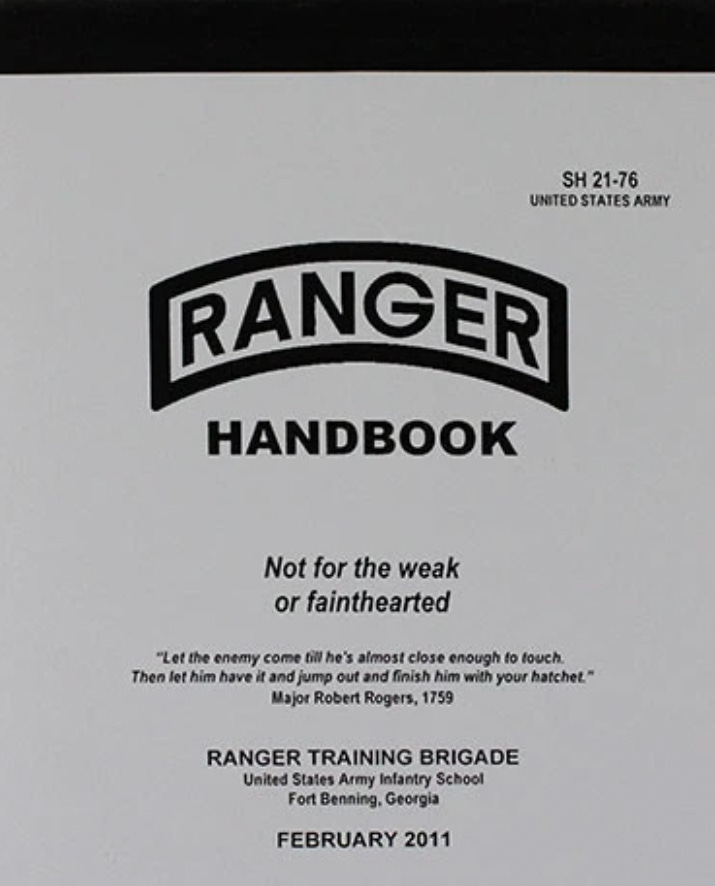Brady Moore (BM) is a longtime friend of WITI and a former Green Beret officer. Today he’s Director of Mission Support at Cesium in Philadelphia. He’s written extensively about how to translate the planning process that he’s used in harsh/unforgiving environments into the business/startup realms. Here, he talks about how to translate a well-worn model into business and life applications. -Colin (CJN)
Brady here. If you measure the value of a model by how often it’s used, the 5-Paragraph Operation Order or OPORD is top dog. More a communication model than a strictly mental one, the format ensures the leader communicates everything that's important- no more and no less. Intended to be read or briefed, it’s used across every branch of the US Army and Marine Corps at every level. Once issued it can be updated with a Fragmentary Order or FRAGO which covers only the parts that need to change. I'll go over each paragraph and its critical parts and explain why they're important.
SITUATION. This paragraph ensures the receivers have all the right information on a few different areas: the enemy, friendly units, and terrain. It’ll also provide the team with a setting by which they can visualize the operation itself.
Enemy Forces. This includes the enemy’s composition, disposition, strength, recent activities, and known/suspected locations and capabilities. Leaders end this part with a statement on the enemy's most likely and most dangerous course of action, described on a map. Often leaders also use this part to describe important terrain factors.
Friendly Forces. Here leaders state the mission and intent of the higher unit, 2 levels up - essentially “here’s my boss’s mission and purpose, and here's his boss’s mission and purpose.” Leaders also mention friendly units to the left, right, front, and rear with their tasks and purposes and how they’ll influence the mission.
Leaders also describe anyone that's going to be attached or detached from the unit.
MISSION. State the mission using the 5 Ws: Who, What (also known as the task), When, Where and Why (the purpose). It should be a clear and concise statement. When presented it's often read twice out loud and the exact location of the objective and the unit’s present location is pointed out on the map. This part is key because it tells everyone very succinctly what’s going to happen and when - it’s the whole thing in a nutshell and a great reference tool throughout the operation.
EXECUTION. Here is where the leader states the commander’s intent including any key tasks which absolutely must be accomplished, as well as what the enemy, friendly units, and terrain should look like following the operation (also known as the endstate).
Concept of Operation. Here the leader describes how the unit will accomplish its mission from start to finish - and this statement should also be concise and clear. At a minimum, it should describe the form of maneuver or defensive technique and the critical events taking place (including what the decisive point of the operation is and why). Leaders generally talk through the concept of the operation like a story with a simple sketch to help them convey the information. They give each subunit a role to play with one having the main effort and the rest acting as supporting efforts.
Maneuver. This part details the mechanics of the operation and can get pretty detailed. The main effort’s mission must be supported by the subordinate unit’s missions.
Additional information: Here the leader covers fires, casualty evacuation, risk reduction control measures and Rules of Engagement (ROE) as well as any specific tasks to maneuver and support units. Any other coordinating instructions are listed including time schedules. Commander's Critical Information Requirements (CCIR) are also listed here including the intelligence that the commander must have for planning and decision making.
Commander’s Intent is often seen at the most important part of the entire order because it can guide everyone through the rest of the operation even if everything changes and if communication is cut off. Concept of the Operation is critical that it be both very clear and as visual as possible so that everyone can begin to play the intended actions through their mind and understand the role they play in the larger effort.
SERVICE SUPPORT. These include matters of supplies (including food, water and ammunition), Medical Evacuation and hospitalization of both friendly and enemy personnel and the handling of enemy prisoners of war. Often overlooked if not included deliberately, these matters are key for sustaining operations beyond a day or two and can require a significant amount of coordination to do right. Medical evacuation is something that’s absolutely time-critical, so coordinating in advance is a must.
COMMAND AND SIGNAL. This paragraph covers where key leaders are located during each phase of the operation. Succession of command is also described as well as methods of communication, signals, and codewords by priority (usually following a PACE model). Knowing who’s in charge if leaders are incapacitated or out of communication is key for military operations and can make sure things roll on smoothly if this occurs. Communications are notorious for failing in operations, so everyone knowing which method to jump to when the radio dies is critical.
All of this is usually followed up by brief-backs to ensure everyone receiving the information understands what they need to understand.
Why is this interesting?
So why give all this information to your subordinates - isn't this a waste of time? First - this method ensures nothing important is left out - in time-constrained situations, it’s a human tendency to leave out things that we don’t think are important in the moment, but which end up being rather important later. But more importantly, the way that US ground forces operate - often called mission command - should create a level of subsidiarity that pushes all decisions to the lowest possible level. It ensures that the person making the decision has the most up-to-date picture of the situation - often because they’re in the middle of it when they make the call. It reduces risk considerably and speeds up operations when done right.
What mission command requires, though, is a thorough understanding of the intent behind the larger operation so that when the plan changes - and as we all know it does change rather quickly - that lower-level leaders can pivot and remain on the right path by knowing what the end goal is. It often doesn’t matter how they get there - what matters is that they arrive at that correct end state on time. Being able to visualize the operation - from the enemy to the terrain and through all phases of the proposed mission - lets each member know what to expect and with the commander’s intent what to aim for when everything else changes.
I use this OPORD model at work when I need to convey information about an upcoming event where background, the plan on the ground, and the overall intent for the action needs to be put across directly. Often people are brought into events who are new to the situation and need that review - or people who are familiar with events need to be updated or have the information confirmed. This model makes sure that I cover the important stuff - and it forces me to think about both the intent for the whole thing, and what might happen that doesn’t fit with my plan or wishes for the outcome. (BJM)
--
WITI x McKinsey:
An ongoing partnership where we highlight interesting McKinsey research, writing, and data.
Tech trends for 2022. What technology trends are top of mind for business? We asked leaders in industry, academia, and at McKinsey to share their perspectives on what’s likely to headline business agendas this year, trends that could—but shouldn’t—slip through the cracks, and what executives should think about when considering new technologies. Here’s what they told us.
--
Thanks for reading,
Noah (NRB) & Colin (CJN) & Brady (BM)
—
Why is this interesting? is a daily email from Noah Brier & Colin Nagy (and friends!) about interesting things. If you’ve enjoyed this edition, please consider forwarding it to a friend. If you’re reading it for the first time, consider subscribing (it’s free!).






SMEAC is endlessly useful. Next post cover CARVER!